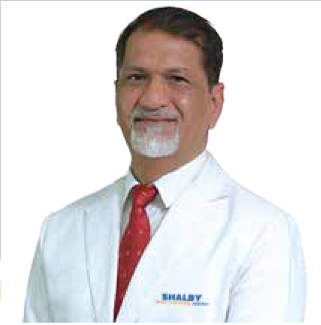 Book Appt.
Book Appt.
 Call Now
Call Now


SHALBY Sanar International Hospitals bring together a team of India’s top orthopaedic experts and Joint Replacement specialists, holding unparalleled expertise, with a vast experience in the field. The hospital has a fully-equipped Orthopaedics & Joint Replacement Department, dedicated to both, clinical and surgical excellence. The Department is backed by the latest, state-of-the-art interventions that add a touch of safety and precision to every treatment plan. At SHALBY Sanar, we cater to our patient’s needs with comprehensive treatment plans that are curated using a personalised approach. We believe that accurate diagnosis plays a crucial role in the effective treatment of any condition and offer the finest imaging and diagnostic modalities to make it possible. The department has a dedicated unit to address a wide range of complex musculoskeletal problems including degenerative diseases, injuries, congenital conditions and deformities.
SHALBY Sanar is widely recognised for offering the finest joint replacement facility, supported by best-in-class innovations and leading-edge technology. Joint replacement is one of the most common orthopaedic interventions that involve the surgical replacement of a damaged or diseased joint with a prosthetic component. It is a preferred treatment option for patients suffering from degenerative joint diseases like arthritis. Our joint replacement team specialises in both, conventional, as well as robotic joint replacement.
AREAS OF EXPERTISE
Carpal Tunnel Syndrome (CTS) is a common and often painful condition that aff...
Low back pain is a common ailment that affects millions of people worldwide. ...
Osteoporosis is a condition that weakens bones. It reduces the density and th...
The knee, a complex and crucial joint, plays a pivotal role in supporting the...
Paget's Disease of the Bone, also known as osteitis deformans, is a chron...
The shoulder is a complex and highly mobile joint that plays a crucial role i...
Soft-tissue injuries encompass a wide range of injuries that affect the body&...
Rheumatoid arthritis is a chronic autoimmune disease characterized by inflamm...
A hip fracture is a serious injury that occurs when the femur (thigh bone) br...
An infected joint replacement, also known as prosthetic joint infection (PJI)...
Hip replacement is a surgical operation. An orthopaedic surgeon will replace ...
Arthroscopy is a surgical procedure to diagnose and treat your joint’s ...
Tennis elbow is a condition that causes pain and inflammation in the elbow. I...
Hip pain is pain or discomfort felt in or around the hip joint. A joint is a ...
Osteomyelitis is a bone infection. It occurs when a bacterial or fungal infec...
Frozen shoulder is a painful condition in which shoulder movement is limited....
Scoliosis is an unnatural side-to-side curving of the spine. Your spine (back...
The aim of physiotherapy and rehabilitation is to improve the quality of the ...
It is a relatively new, yet highly effective joint replacement procedure, tha...
The Department of Arthroscopy and Sports Medicine at SHALBY Sanar Internation...
It is a new-age joint replacement technique that uses real-time navigation an...
Orthopaedic problems are usually acquired after birth, but some are born with...
This surgical intervention is not as common as other joint replacement proced...
The procedure ranks second in the list of most common joint replacement proce...
With more than 2.5 lakh people undergoing the procedure in India every year, ...
It is an advanced surgical technique that is recommended for patients with bo...
These refer to benign or malignant growths that develop on the bones as a res...
The Department of Bone, Joint and Orthopaedics is dedicated to providing cutt...
Every year, thousands of people opt for shoulder replacement surgery in India...
It is a branch of orthopaedics that addresses orthopaedic problems in childre...
It is a specialized branch of orthopaedics solely dedicated to offering robus...
The feet, often taken for granted, are the unsung heroes of our mobility. The...
Fractures, commonly known as broken bones, are a prevalent type of injury tha...
The hands are incredibly versatile and essential for performing a wide range ...
This department specializes in diagnosing, treating, and managing conditions related to the musculoskeletal system, including bones, joints, ligaments, tendons, and muscles. Services include fracture management, joint replacement, arthritis care, and sports injury treatment.
Common procedures performed in this department include joint replacement surgery, arthroscopy, fracture repair, and spinal surgery.
Consult an orthopaedic doctor if you have persistent joint or bone pain, difficulty moving a joint, swelling, redness, or warmth around a joint. Suspected fracture or sports injury, as well as chronic back or neck pain.
Joint replacement surgery removes damaged joint elements and replaces them with artificial implants (prosthetics). It is often indicated for severe arthritis or injuries that have not responded to previous therapies.
Yes, depending on the condition, alternatives may include physical therapy and exercise, medications for pain and inflammation, steroid injections or hyaluronic acid injections, and assistive devices like braces or walkers.
Orthopaedic conditions are typically diagnosed through a combination of physical examinations, medical history reviews, and diagnostic tests. These tests may include X-rays, MRI scans, CT scans, bone scans, blood tests, and arthroscopy (a minimally invasive procedure to visualize and diagnose joint problems).
It maintains a healthy weight to reduce joint stress, exercises regularly to develop muscles and bones, employs the right techniques during physical activities to avoid injury, maintains excellent posture whether sitting, standing, or lifting, and consumes a calcium and vitamin D-rich diet to promote bone health.
You can discover a qualified orthopedic specialist by getting a referral from your doctor or asking friends and relatives for suggestions. To make your task easier, contact SHALBY Sanar International Hospitals or visit https://www.sanarhospitals.com/orthopaedics-and-joint-surgery for help. We can connect you with the greatest orthopaedists in your area.
The recovery period following orthopaedic surgery varies depending on the type of surgery performed, the precise ailment being treated, and personal characteristics. Minor treatments may have shorter recovery durations, whereas more extensive surgeries may take several weeks or months to fully recover. Your orthopedic surgeon will provide detailed instructions and directions for your recovery.
The cost of broken or fractured bone surgery might range between INR 50,000 and INR 5,00,000 or more. This estimate covers costs for the surgery, hospital stay, drugs, anesthesia, surgeon's fees, pre-operative tests, post-operative care, and follow-up appointments. It is also worth noting that the cost can fluctuate greatly when these elements alter.
An orthopedic doctor or surgeon will treat any problem that affects the musculoskeletal system. They not only evaluate and treat orthopedic conditions, but they also assist with rehabilitation and the development of preventative measures for future accidents or damage to musculoskeletal tissues.
The cost of hand surgery (for example, carpal tunnel release surgery) in India varies based on a number of factors, including the procedure's intricacy, the surgeon's experience, the location of the healthcare institution, and any other services required. Hand surgery in India typically costs between INR 20,000 to INR 1,50,000 or more. This estimate usually includes the surgeon's expenses, anesthetic costs, hospital or surgical facility fees, pre-operative assessments, post-operative care, and follow-up appointments. Additional charges may apply for specialist diagnostic tests, imaging examinations, medications, and rehabilitation services.
Arthroscopy is a minimally invasive treatment for diagnosing and treating joint issues that use a small camera and specialized equipment. It treats diseases such as ligament tears, cartilage damage, and inflammation.
Most joint replacements survive 15 to 20 years or more. Longevity is determined by the type of implant, patient activity level, and weight.
Physiotherapy improves mobility and strength following surgery or accident, manages chronic disorders such as arthritis, and prevents future joint or muscle problems.
SHALBY Sanar International Hospitals provides extensive medical procedures backed up with our state-of-the-art technology and a team of highly qualified & experienced clinical experts.




Life Transformed: Mr. Blojah Felix Journey to Pain-Free Living | SHALBY Sanar

Pain-Free Living After 6 Years: Knee Replacement Success Story | Dr. Rohit Lamba

Bilateral Total Knee Replacement by Dr. Vikram Shah | SHALBY Sanar International Hospitals

Remarkable Recovery Story: Hip Replacement for Non-union Fracture

Incredible Recovery Story: Bilateral Knee Replacement Transformation

Knee Replacement Surgery by Dr. Rohit Lamba: 60-Year-Old's Remarkable Recovery

Renewed Hope: Successful Hip Replacement Surgery Transforms Iraqi Patient's Life

Exploring a Case of Revision Knee Replacement: Insights from Dr. Rohit Lamba

Triumphant Journey: Ms. Fatima, 69, Triumphs Over Revision Knee Replacement Surgery

Leaving the crutches behind – Riyaz, 43, gains confidence after a successful Hip Replacement Surgery

Transformative Total Knee Replacement Surgery: A New Lease on Life for 48-Year-Old Ramesh

Miraculous Recovery: 17-Year-Old Kenyan Overcomes Osteosarcoma with Mega Prosthesis Surgery

Mr. Omar Faruk's Remarkable Knee Recovery: ACL Reconstruction Success Story

Mrs. Vijay Luxmi's Remarkable Knee Replacement Journey

Umidjon, 36, from Uzbekistan shares his gratitude for a successful total hip replacement surgery

Ms. Mohsin from Iraq shares her gratitude for a successful Computer Navigated Total Knee Replacement

A Total Hip Replacement surgery gives Ms. Barry from Ghana, the ability to walk again.

Dr. Rohit Lamba talks about a successful Hip Replacement Surgery carried out on an Iraqi patient